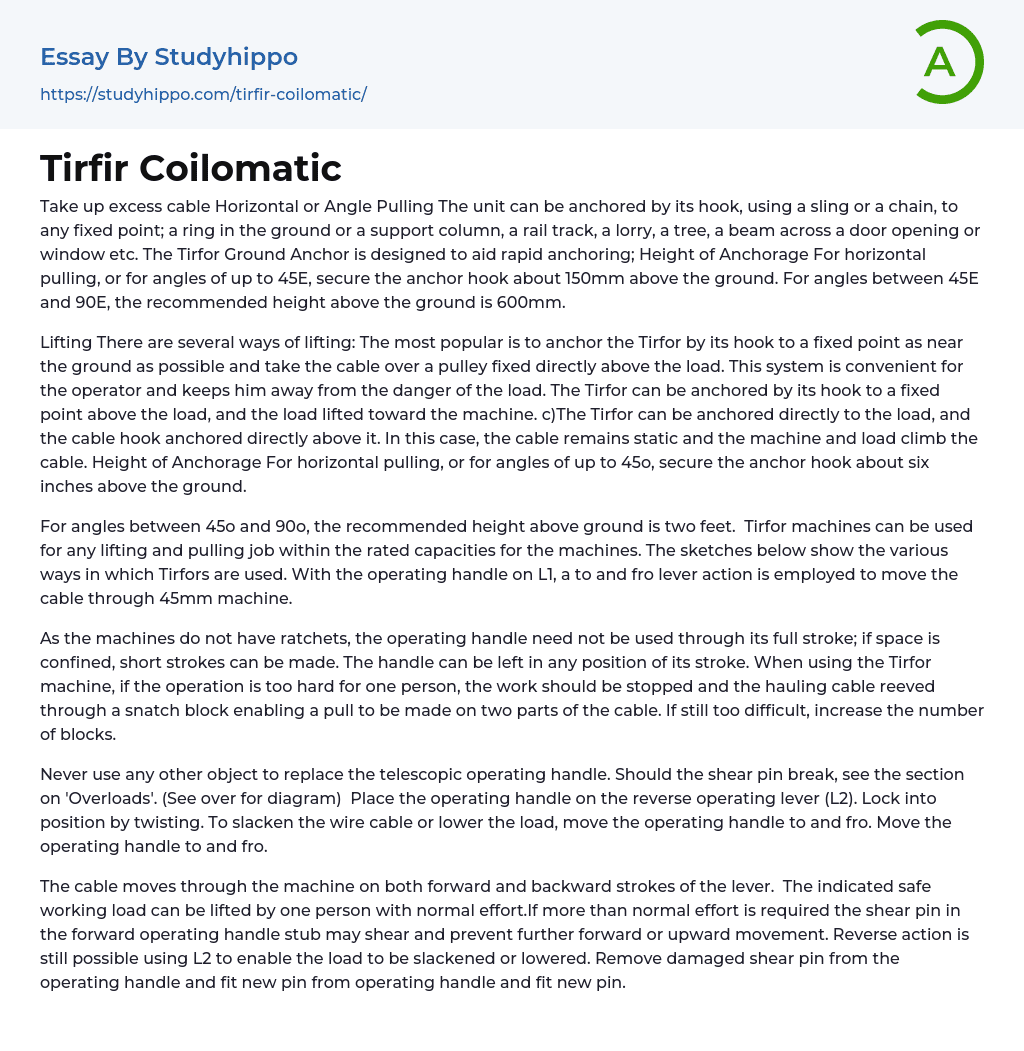The unit can be secured in various ways, such as using a sling or a chain, to any fixed point like a ring in the ground, a support column, a rail track, a lorry, a tree, or a beam across a door opening or window. The Tirfor Ground Anchor is specifically designed to make anchoring quick and easy. For horizontal pulling or angles up to 45E, it is recommended to secure the anchor hook about 150mm above the ground. If the angle is between 45E and 90E, it is suggested to have the anchor hook positioned at least 600mm above the ground.
There are multiple methods for lifting with the Tirfor. The most common approach involves securing its hook to a fixed point as close to the ground as possible and running the cable over a pulley that is directly above
...the load.
This system is beneficial for the operator as it helps to minimize the potential danger by keeping him away from the load. The Tirfor has the option of being fastened to a secure point above the load using its hook, enabling the load to be raised towards the machine. Alternatively, the Tirfor can be directly connected to the load with its cable hook positioned above it. In this case, while ascending along it, both the machine and load move along a stationary cable.
The height of the anchorage for horizontal pulling or angles up to 45o should be about 6 inches above the ground. For angles between 45o and 90o, it is recommended to secure the anchor hook at a height of two feet above the ground. Tirfor machines are versatile and can be use
for lifting and pulling tasks as long as they do not exceed the rated capacities. The diagrams below depict different applications of Tirfors. When using the operating handle on L1, a lever action is utilized to move the cable through the 45mm machine. The machines do not have ratchets, so the operating handle does not need to be used through its full stroke. In cramped spaces, short strokes can be performed. The handle can be placed in any position during its stroke.
When using the Tirfor machine, if one person finds the operation too challenging, they should stop the work. Then, reeve the hauling cable through a snatch block to allow pulling on two parts of the cable. If the task is still too hard, add more blocks. It is crucial to never substitute the telescopic operating handle with any other object. In case the shear pin breaks, refer to the 'Overloads' section.
(See over for diagram) Place the operating handle on the reverse operating lever (L2) and twist to lock into position. To slacken the wire cable or lower the load, move the operating handle back and forth.
The cable moves through the machine in both forward and backward strokes of the lever. One person can lift the indicated safe working load with normal effort. If more effort than normal is needed, the shear pin in the forward operating handle stub may shear and prevent further forward or upward movement. However, reverse action is still possible by using L2 to slacken or lower the load. To fix this issue, remove the damaged shear pin from the operating handle and replace it with a new one.
Spare pins can be found in the cable release lever. It is important to avoid using non-standard shear pins as they can cause damage to the machine. Remember to order replacement pins and keep them in the cable release lever.
To ensure that all the cable gripping mechanisms are in proper working order, it is important to perform lubrication as per Standard Test Records 15. For this, place the reversing lever L2 midway in the slot and apply oil in front and behind the lever. This will ensure that both jaws receive adequate lubrication. Failure to lubricate a Tirfor properly can lead to a condition known as 'pumping'.
This problem arises when one jaw of the machine's grip becomes stuck on the cable, preventing the other jaw from taking on the load. When the operating handle is pulled down, the machine climbs 25mm up the cable. However, when the handle is moved up again, the machine moves down the same 25mm due to the jaw being locked onto the cable. Another sign of inadequate lubrication is a jerky motion when lowering the load. It is crucial not to exceed the machine's maximum working load and to only use it for its intended applications. Trying to operate the cable release mechanism while the machine is under load should never be attempted. Additionally, one should never obstruct the operating levers or the cable release lever, nor operate the forward and reverse levers simultaneously.
- Flowchart essays
- Integrated Circuit essays
- Tracking system essays
- Hard Disk Drive essays
- Building essays
- Computer Components essays
- Computer Peripherals essays
- Personal Computer essays
- Automotive essays
- Automotive Industry essays
- Commerce essays
- Construction essays
- E Commerce essays
- Grocery stores essays
- Paper Industry essays
- Pharmaceutical industry essays
- Pharmacy essays
- Polymers essays
- Real Estate essays
- Textile Industry essays
- Automobile essays
- Bus essays
- Civil engineering essays
- Cycling essays
- Electric Car essays
- Genetic Engineering essays
- Hybrid essays
- Innovation essays
- Internal Combustion Engine essays
- Invention essays
- Mechanical Engineering essays
- Mechanics essays
- Software Engineering essays
- Telephone essays
- chrysler essays
- Racing essays
- Renault essays
- The city essays
- Truck essays




